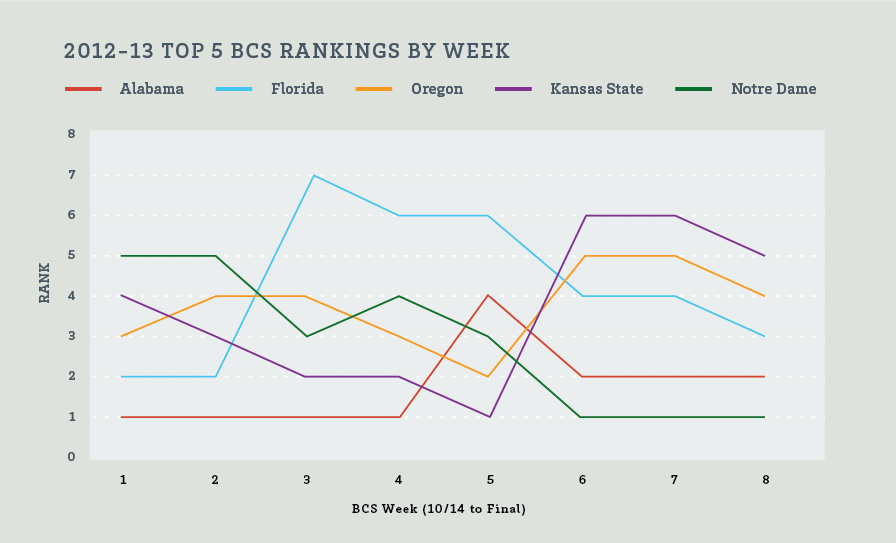Key Takeaway
Historically about 80% of the initial top 25 will remain there at the regular season’s conclusion.
The Bowl Championship Series (BCS) has been in place since the 1998 season and in this piece we look back at how well these initial rankings have predicted final standings. We’ll analyze the specific components of the BCS rankings to determine what extent the various human and computer polls agree with each other, highlight the greatest disagreement in the last three seasons, and look at the power of each initial human and computer poll to predict final BCS rankings.
The Predictive Power of Initial BCS Rankings
In general, how well historically have initial BCS rankings predicted final BCS rankings? The answer is fairly well. On the average, about 80% of the initial top 25 will still be on the board at the regular season’s conclusion. However, if history is any indicator, there will be surprises as well.
Table 1 provides a summary of the movement among the top 25 in the BCS from the initial rankings (in mid October) to the final rankings. The table begins in 2004-05 (the first year that the week 1 rankings included 25 teams). 2012-13 was particularly tumultuous in that only 17 of the initial top 25 remained in the top 25 at the final rankings. In contrast, 22 of the 2009 initial top 25 stayed among the top 25.
For the purposes of Table 1 and Table 3 (below), any team outside of the top 25 was considered to be ranked 26th. So, if a team fell from 22 out of the rankings, their change in ranking would be -4. A team that was initially unranked, but finished 20th, would have a net change of +6. In Table 1, the 3rd column labeled Avg. Change gives the average absolute value of the change in position from initial to final BCS rankings. Also included in Table 1 are the teams that climbed the most and the teams that dropped the most in the rankings each year.
Table 1: Summary of Movement from Initial to Final BCS Rankings
| Year | # Fall Out | Avg Change | Biggest Rise (# of spots) |
Conf. | Biggest Fall (# of spots) |
Conf. |
| 2004 | 4 | 5.3 | Virginia Tech (17) | ACC | Purdue (14) | Big Ten |
| 2005 | 5 | 5.3 | Ohio State (11) | Big Ten | Florida State (11) | ACC |
| 2006 | 6 | 5.9 | LSU (14) | SEC | Clemson (14) | ACC |
| 2007 | 6 | 7.2 | Georgia (15) | SEC | South Carolina (20) | SEC |
| 2008 | 6 | 4.7 | Cincinnati (14) | Big East | LSU (13) | SEC |
| 2009 | 3 | 4.3 | Ohio State (11) | Big Ten | USC (17) | Pac-10 |
| 2010 | 4 | 5.4 | Arkansas (15) | SEC | Iowa (11) | Big Ten |
| 2011 | 4 | 4.4 | Baylor (14) | Big 12 | Oklahoma (11) | Big 12 |
| 2012 | 8 | 5.7 | Stanford (14) | Pac-12 | USC (16) | Pac-12 |
In 2012-13, more teams that were initially in the top 25 fell out by season’s end than in any of the previous 8 seasons. We now pay particular attention to that 2012-13 season.
Given that the current BCS structure has a playoff system with only 2 teams, the movement among the top 5 teams in the rankings is particularly important. Chart 2 tracks the week-by-week BCS rankings of the top 5. The games just prior to the Week 6 (November 18) rankings were pivotal. That week, number one and number two, Kansas State and Oregon, both lost, opening the door for Notre Dame to claim, and Alabama to reclaim a top two spot.
Chart 2: 2012-13 Top 5 BCS Rankings by Week
Each year, at least one team in the initial top 25 falls significantly, and one team climbs a number of spots. There is no general trend across the seasons in the conferences of the biggest movers. In a particular season, however, certain conferences can see their top teams improve or regress collectively. In 2012-13, all three Big East teams initially ranked in the top 25 fell at least 5 spots. In contrast, the Big Ten had no teams in the initial BCS top 25. By season’s end, the conference had three teams, ranked 12th, 19th, and 22nd. Table 3 presents the average movement by conference from the initial to final BCS rankings among the teams ranked in the top 25 in either week.
Table 3: Average Movement from Initial to Final 2012-13 BCS Rankings by Conference
| Conference | # Schools | Average Movement |
| ACC | 2 | -3.5 |
| Big 12 | 7 | 4.0 |
| Big East | 3 | 7.0 |
| Big Ten | 3 | -8.0 |
| Ind. | 1 | -4.0 |
| MAC | 2 | -6.0 |
| MWC | 1 | -3.0 |
| Pac-12 | 5 | -0.2 |
| SEC | 7 | 1.1 |
| WAC | 2 | -3.0 |
Win AD equips your athletic department with better tools to predict your own financial performance with easy benchmarking—customizable comparisons of revenue and expense trends between institutions. Get a 4-year view of NCAA financials in the same place you compare wins/losses, post-season performance, APR, and RPI for every sport—from football to fencing. Win AD is a better way to manage resources and maximize performance.
Contact us for a free demo of Win AD





